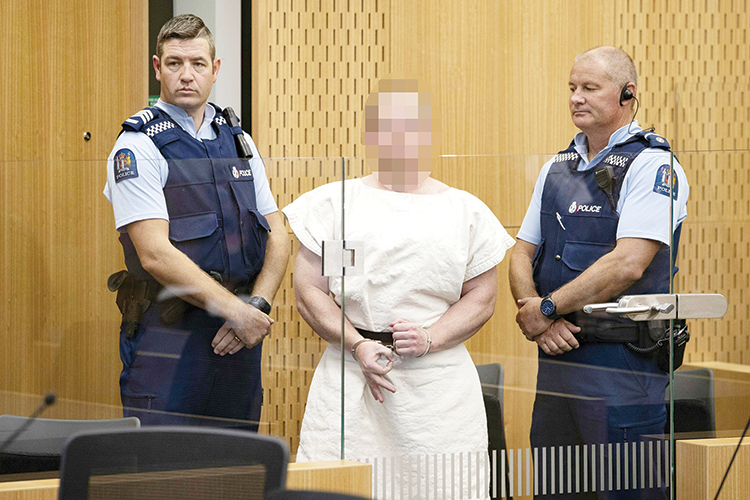
WASHINGTON: The
massacre of Muslims at New Zealand mosques on Friday demonstrated the global
reach of a white nationalist movement that preaches an imagined
"European" ideal, rejects immigration and shares often vicious
threats over the Internet. It's leaderless, fragmented, and relies for
attention on lone-wolf type attackers like the 28-year-old Australian terrorist
Brenton Tarrant, who killed 49 people Friday in Christchurch, explaining in a
manifesto that he wants to "crush immigration" and revenge terror
attacks on Europe.
But experts say
it is a cohesive movement bound together online that stretches across Europe
into Russia, has a deep following in the US and Canada, and as Friday's attack
showed, is present in Australia and New Zealand. They say it poses as much of
an international threat as Islamic extremism, and even more so in the United
States where white nationalist attacks have outpaced those by jihadists for
years.
"White
nationalism and far-right extremism is the most prominent extremist threat
facing the United States today, and indeed it is a worldwide phenomenon,"
said Brian Levin, director of the Center for the Study of Hate and Extremism at
California State University, San Bernardino. "These folks fear demographic
change. They use the term white genocide," he said.
The white
nationalist movement has roots in concepts espoused decades ago by European and
American fascists and neo-Nazis. French historian Nicolas Lebourg noted that
the Christchurch suspect's manifesto cited British 1930s fascist Oswald Mosley,
who developed the idea of a planet organized by race. His use of the word
"Europeans" for whites was first promoted in the late 1940s by
American neo-Nazi Francis Parker Yockey. "White genocide" is an idea
that appeared around 1972 in the United States, Lebourg noted, and was then
popularized in Europe by French writer Renaud Camus.
Indeed, the
suspect's manifesto was titled "The Great Replacement," the title of
a 2011 book by Camus, popular in white nationalist circles, that argued that
non-white immigrants are supplanting white Europeans. But their ideas are not
uniform - some white nationalists are anti-Muslim, some anti-Jewish, some
capitalist, others socialist. What unites them today, analysts say, is their
fundamental opposition to immigration.
Vanderbilt
University professor Sophie Bjork-James said a common fear was that white
Christians could become minorities in societies they have dominated for
centuries. This has given rise to movements like the France-rooted
"Identitarians," and Identity Evropa in the United States. White nationalists have been further
emboldened by the rise of politicians espousing traditionalist views and a
tough line on immigration - from Marine Le Pen in France and Viktor Orban in
Hungary to Russian President Vladimir Putin; and the UKIP party in Britain.
The same holds
true in the United States where President Donald Trump campaigned for the White
House on an anti-immigration platform, backed by an overwhelmingly white voter
base. Trump notoriously appeared to sanction the march by white supremacists
and neo-Nazis in Charlottesville, Virginia in 2017, and has avoided condemning
violence from the far-right. Bjork-James said, "They see him as an
incredible opportunity to broaden their influence."
The Christchurch
suspect called Trump "a symbol of renewed white identity and common
purpose". While he was swift to condemn the massacre, Trump courted
controversy once again on Friday by saying he did not think it showed white
nationalism to be a growing problem worldwide. "I don't really. I think
it's a small group of people," he told reporters in the Oval Office.
Bjork-James said
the internet, especially sites like GAB and Stormfront, have helped build a
global community for the otherwise disparate white nationalists.
"Stormfront is a global clearinghouse for white nationalism," she
said. It was filled with comments early Friday on the Christchurch attack, with
some questioning the murder of women and children. One commenter rejected the
debate, she noted, by saying chillingly: "Invaders are not innocent
people."
She said overall
the movement operates consciously as a "leaderless resistance", whose
members aimed to inspire each other into action. "The lone-wolf attack is
actually a part of a global strategy," said Bjork-James.The Christchurch
suspect wrote that he took inspiration from other white nationalists who
undertook mass killings. He cited Anders Breivik, who slaughtered 77 people in
Norway in 2011; Dylann Roof, who killed nine African-Americans in a US church
in 2015; Alexandre Bissonnette, who murdered six in a 2017 attack on a Canadian
mosque; and others like them.
But Lebourg said
that attacks more recently appear to have become part of a cycle of revenge,
especially since the bombings that targeted France in 2015. The suspect's
manifesto supports that: He cites revenge for historical events and recent
Islamist extremist attacks multiple times. The 2015 attacks were "a tipping
point for all the supremacists", Lebourg said. "Now revenge is in
people's heads." - AFP










